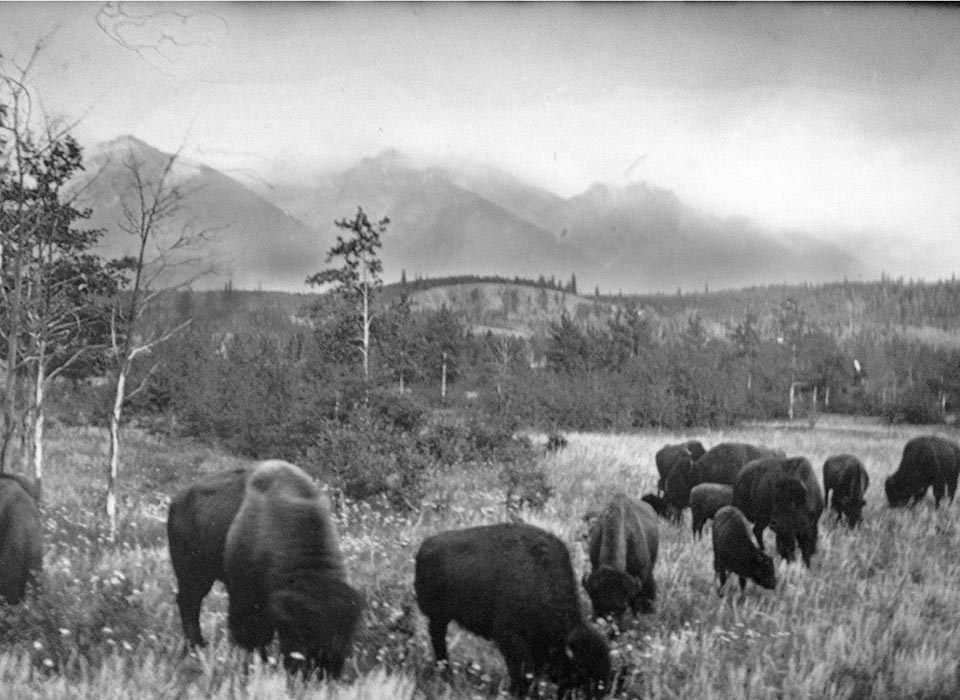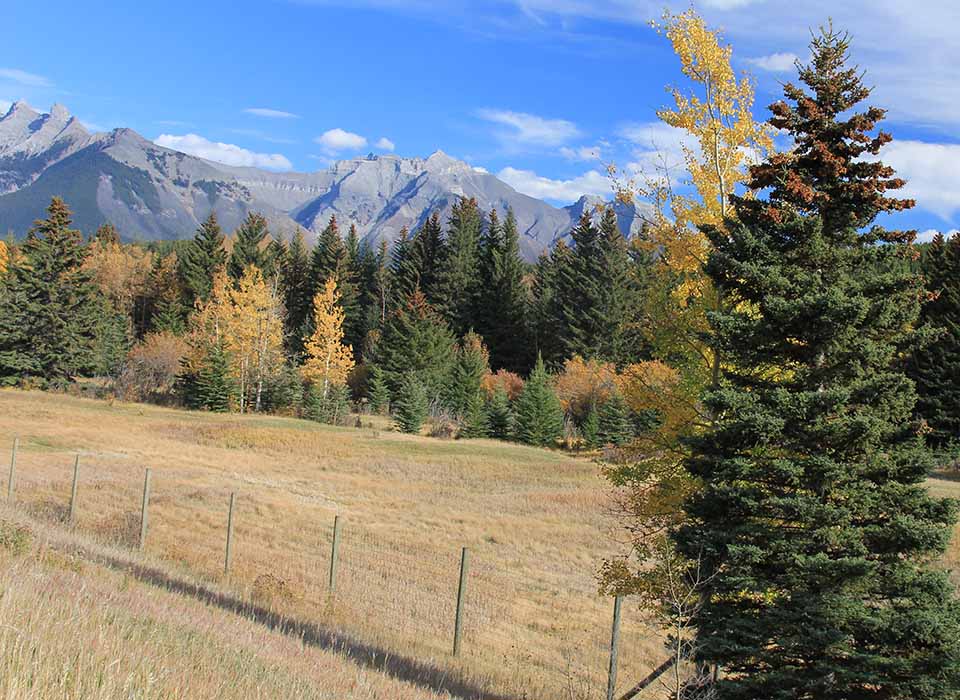Bison (commonly called buffalo) grazing after recently being released into a paddock in Banff National Park in c. 1898 (photographer unknown, Whyte Museum of the Canadian Rockies) and the same area in 2015 (CW-2015-10-07-464). The early image was likely taken off the railroad, looking southeast into the fenced pasture used to hold bison in the 1890s. The retake was moved back about 100m to the edge of the Trans Canada Highway because the view from the railroad (in the recent photograph’s mid-ground) is now largely obscured by a dense stand of white spruce.
One of the largest areas of grassland and open aspen shrubland within the current boundaries of Banff National Park once lay between Forty Mile Creek and the Cascade River, just northeast of the town of Banff. This was an ecologically rich habitat of small grasslands, interspersed with willow, groves of aspen, and a meandering stream that periodically held beaver. Small groups of bison likely historically moved into this area from the nearby plains. In August, 1859 James Hector recorded the last signs of wild bison in the Banff park area near Pipestone Pass on his trip from the Bow to the North Saskatchewan valley.1 Native predators and First Nation use of the Rocky Mountains likely kept the numbers of their favoured species such as bison and elk generally low, and when combined with European hunting, this resulted in the extirpation of populations from large areas.2
The Banff Park Zoo
After the national park was established near Banff, a first order of business to attract tourists was to control human hunting to increase wildlife numbers, and if necessary, to bring captured native (or even exotic) species back into the park. Historian Eleanor Luxton described the building of a zoo and paddocks east of town that eventually housed a menagerie of species:
The first gift of three buffalo was from T. G. Blackstock, Q.C., of Toronto in 1897; then, in 1908, sixteen were given to the park by Lord Strathcona…they were temporarily housed at the old North West Mounted Police barracks, the log building serving as a shelter, and the grounds being strongly fenced. By June of 1908, the nineteen animals were enclosed on 300 acres, one and a half miles from Banff near Cascade Mountain in a place visible from both the railway and the road to Lake Minnewanka, an advantage to visitors. By 1899, there were thirty buffalo, all doing well. Wapiti, moose, deer, Angora goats, Bighorn sheep, and in 1912, six yak, a gift from the Duke of Bedford, were added. In 1907, Howard Douglas went to Montana to bring the Pablo Buffalo Herd back to Canada. 3
The purchase by the Canadian government of Michel Pablo’s large buffalo herd that ranged across the Flathead Indian Reserve in Montana, was a momentous occasion for Canadian conservationists. Eventually over 700 bison were captured along the Flathead River, squeezed into reinforced stock cars, and transplanted northwards across the border. Banff received 77 of these animals, and a new paddock was built north of the railroad to hold the increasing herd. 4
Modern Human Impacts near Banff
Although the wildlife paddocks have now been removed, today this area remains extensively impacted by roads, the railway, water-supply wells, and the nearby industrial facilities associated with the town of Banff. High densities of elk are attracted here because predators avoid this area of high human use.5 Intense browsing by elk has stunted aspen and willow, and fire suppression is allowing a dense forest of white spruce underlain by moss to advance across what was once a scenic vista of meadows, aspen groves and shrubfields. The nearby stream, once clogged with beaver dams built from willow and aspen, is now devoid of plants used by beaver, and is dry along most its former course. 6
Footnotes and Map
- Spry, I. M., ed. The Papers of the Palliser Expedition, 1857–1860. Toronto: Champlain Society, 1968, 441-442 ↩
- Kay, C. E., B. Patton, and C. A. White. “Historical Wildlife Observations in the Canadian Rockies: Implications for Ecological Integrity.” Canadian Field Naturalist 114 (2000): 561–83. ↩
- Luxton, E. G. Banff: Canada’s First National Park. Banff: Summerthought, 1975, 88-89. ↩
- Luxton, Banff, 136-143; Locke, H. ed. The Last of the Buffalo. Return to the Wild. Banff: Summerthought, 2016. ↩
- Hebblewhite, M., C. A. White, C. G. Nietvelt, J. A. McKenzie, T. E. Hurd, J. M. Fryxell, S. E. Bayley, and P. C. Paquet. “Human Activity Mediates a Trophic Cascade Caused by Wolves.” Ecology 86 (2005): 2135–2144. ↩
- White, C.A., A. Buckingham, and M. Hebblewhite. ‘Shrubwatch’ Monitoring, Bow Valley, Banff National Park. Report to Parks Canada. Banff, AB. 2011. ↩

